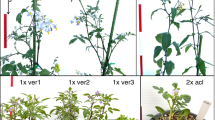Summary
The variation which persisted in interspecific aneuploids even after one or two generations of backcrossing prevented the morphological distinction of the aneuploids from their diploid sibs. An attempt was made to unmask the effects of aneuploidy by producing aneuploids within the more uniform genetic background of a single species.
The procedure to produce trisomics and aneuploids of diploid species was to vegetatively double clones or seed of the species with colchicine, cross the induced tetraploids to diploids to produce triploids, and then cross the triploids to the original diploids. An attempt was made to use the same diploid clone and/or introduction of a species in all successive stages of the procedure in order to obtain as much uniformity as possible. This was largely unsuccessful because self-incompatibility and inbreeding reduced seed set. Seventy-three different tetraploids were obtained from seven species. Tuber treatments were noticeably unsuccessful in producing doubled plants. The two vegetative treatments were most successful and produced 41 different tetraploid clones while 30 doubled plants were obtained from four seed treatments.
Morphologically the tetraploids resembled the diploid and there was no noticeable increase in size of leaflets and floral parts in the tetraploid. The average number of chloroplasts in ten pairs of guard cells was a distinctive feature which could efficiently be used in distinguishing the induced tetraploid plants from diploids. The tetraploids were generally less fertile than their diploid counterparts and the majority of them exhibited self-compatibility in comparison to self incompatibility of the diploids.
Similar content being viewed by others
References
Beamish, K. F., D. C. Cooper & R. W. Hougas, 1957. Induced tetraploid Solanum species and species hybrids; meiosis and use in breeding. Amer. J. Bot. 44: 305–310.
Cipar, M. S., 1963. Intercompatibility relationships among haploids of Solanum tuberosum subsp. Andigena and certain diploid species. Ph. D. Thesis, Univ. Wisconsin.
Gilles, A., M. Deverux & P. Lhoas, 1956. Recherches cytogénétiques sur les Solanum, section Tuberarium polyploidization expérimentale. Genetica 28: 42–50.
Hollenback, J. G., 1966. Variation in self and pseudo-compatibility in haploid Tuberosum-Phureja hybrid families. Ph. D. Thesis, Univ. Wisconsin.
Howard, M. W., 1961. Potato cytology and genetics. Bibliogr. Genet. 19: 87–216.
Johnstone, F. E., 1939. Chromosome doubling in potatoes induced by colchicine treatment. Amer. Potato J. 16: 288–303.
Kawakami, K. & M. Matsubayashi, 1966. Chromosome doubling in dihaploid potatoes induced by tuber treatment with colchicine, Eur. Potato J 9: 129–136.
Kessel, R. & P. R. Rowe, 1973. Interspecific aneuploids in the genus Solanum. (In press).
Koopmans, A., 1951. Cytogenetic studies on Solanum tuberosum L. and some of its relatives. Genetica 24: 193–337.
Lamm, R., 1945. Cytogenetic studies in Solanum sect. Tuberarium. Hereditas 31: 1–128.
Ross, R. W., L. A. Dionne & R. W. Hougas, 1967. Doubling the chromosome number of selected Solanum species. Eur. Potato J. 10: 37–52.
Ross, R. W. & P. R. Rowe, 1969. Inventory of tuber-bearing Solanum species. Wis. Agr. Exp. Sta. Bull. 533.
Simmonds, N. W., 1962. Abbreviations of potato names. Eur. Potato J. 6: 186–190.
Swaminathan, M. S., 1951. Notes on induced polyploids in tuber bearing Solanum species and their crossability with Solanum tuberosum. Amer. Potato J. 28: 472–489.
Vogt, G. E. & P. R. Rowe, 1968. Auneploids from triploid-diploid crosses in the series Tuberosa of the genus Solanum. Can J. Genet. Cytol. 10: 479–486.
Author information
Authors and Affiliations
Additional information
Cooperative investigations of the Agricultural Research Service, U.S. Department of Agriculture and the Wisconsin Agricultural Experiment Station. Supported in part by grants from the Research Committee of the Graduate School, University of Wisconsin.
Rights and permissions
About this article
Cite this article
Kessel, R., Rowe, P.R. Production of intraspecific aneuploids in the genus Solanum. 1. Doubling the chromosome number of seven diploid species. Euphytica 24, 65–75 (1975). https://doi.org/10.1007/BF00147170
Received:
Issue Date:
DOI: https://doi.org/10.1007/BF00147170




